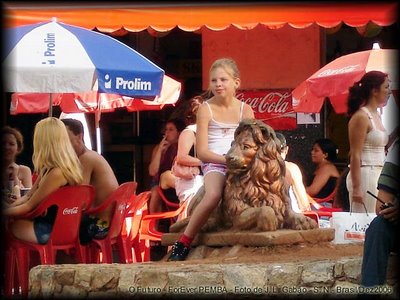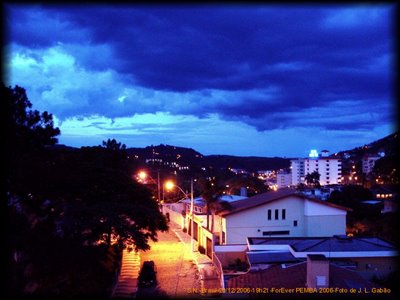
Saudações deste lado do mar para todos o Amigos.
Graças à net e às minha insónias, vou acompanhando, na calmaria das madrugadas quentes aqui dos trópicos, tudo o que se passa pelo mundo e o que meus Amigos deste Bar por cá vão colocando, tentando uns "desabafar" e outros "reanimar" nossos espíritos de certa forma alquebrados ou até um tanto "gastos" pela vida de todos os dias e por acontecimentos a gosto ou não de cada um...
E até a morte do tal Sadam me tocou e agravou minha insónia.
Às quatro da madrugada lá desliguei o notebook e fui para a cama, mas o sono não chegava nem o espírito sossegava...
Graças à net e às minha insónias, vou acompanhando, na calmaria das madrugadas quentes aqui dos trópicos, tudo o que se passa pelo mundo e o que meus Amigos deste Bar por cá vão colocando, tentando uns "desabafar" e outros "reanimar" nossos espíritos de certa forma alquebrados ou até um tanto "gastos" pela vida de todos os dias e por acontecimentos a gosto ou não de cada um...
E até a morte do tal Sadam me tocou e agravou minha insónia.
Às quatro da madrugada lá desliguei o notebook e fui para a cama, mas o sono não chegava nem o espírito sossegava...
Pensei...pensei...E assim, também me permito um "desabafo" que espero entendam. Ou, pelo menos, aceitem minha modesta reflexão de final-de-ano.
Caramba ! Nunca gostei desse ditador-açougueiro, nem de qualquer outro prepotente governante de direita ou esquerda, mas interrogo-me e agravo minhas dúvidas e preocupações a respeito da imparcialidade e coerência de atitudes desses "justiceiros" de araque que vão aparecendo cada dia mais pelos recantos instáves e violentos do mundo, apoderando-se do direito Supremo da vida, e ainda por cima legitimados ou acobertados por potências que são verdadeiros lobos e rapozas travestidos de plácidos e inocentes cordeiros.
Afinal, com que facilidade se mata neste planeta?!
Com que facilidade se julga, condena e se arvoram o direito Supremo de privar da vida outro ser humano?!
Com que facilidade se acusam uns de criminosos e outros, que cometem os mesmos e mais odientos crimes e atentados contra a liberdade dos povos, como Fidel, Sócios & Amigos, de paladinos dos direitos dos desfavorecidos ?!
Como é possível justificar a continuidade da vida assenhoreando-se do poder de tirar essa mesma vida ?!
Qual a diferença entre um Sadam, um Fidel, um Bush, um Chavez ou outro qualquer governante populista desses paises ditos "civilizados" e "democráticos" que, nas entrelinhas de suas atitudes, vão denegrindo a vida justificando a glória da morte através de armamentos nucleares, chacinas e da pena de Talião?!
Caramba ! Nunca gostei desse ditador-açougueiro, nem de qualquer outro prepotente governante de direita ou esquerda, mas interrogo-me e agravo minhas dúvidas e preocupações a respeito da imparcialidade e coerência de atitudes desses "justiceiros" de araque que vão aparecendo cada dia mais pelos recantos instáves e violentos do mundo, apoderando-se do direito Supremo da vida, e ainda por cima legitimados ou acobertados por potências que são verdadeiros lobos e rapozas travestidos de plácidos e inocentes cordeiros.
Afinal, com que facilidade se mata neste planeta?!
Com que facilidade se julga, condena e se arvoram o direito Supremo de privar da vida outro ser humano?!
Com que facilidade se acusam uns de criminosos e outros, que cometem os mesmos e mais odientos crimes e atentados contra a liberdade dos povos, como Fidel, Sócios & Amigos, de paladinos dos direitos dos desfavorecidos ?!
Como é possível justificar a continuidade da vida assenhoreando-se do poder de tirar essa mesma vida ?!
Qual a diferença entre um Sadam, um Fidel, um Bush, um Chavez ou outro qualquer governante populista desses paises ditos "civilizados" e "democráticos" que, nas entrelinhas de suas atitudes, vão denegrindo a vida justificando a glória da morte através de armamentos nucleares, chacinas e da pena de Talião?!
Algo, neste mundo terreno, justificará o direito à morte ?!
Qual a diferença entre esses senhores da morte de milhares de inocentes, os carrascos do Sadam e os marginais que assaltam num recanto pobre de Recife ou Salvador, incendeiam ônibus no Rio ou São Paulo e violentam assassinando a população indefesa em Bagdá ?!
E, porque deveremos considerar uns anjos e outros demónios ? !
Onde estárá finalmente, a razão e a coerência para desejar um bom 2007 que sabemos de antemão não será ?
Ou então será sim, só porque agimos como avestruzes enterrando a cabeça no primeiro buraco do chão fazendo de conta que nada vemos e somos felizes !
Abraço para todos meus Amigo(as),
Jaime Luis Gabão
Qual a diferença entre esses senhores da morte de milhares de inocentes, os carrascos do Sadam e os marginais que assaltam num recanto pobre de Recife ou Salvador, incendeiam ônibus no Rio ou São Paulo e violentam assassinando a população indefesa em Bagdá ?!
E, porque deveremos considerar uns anjos e outros demónios ? !
Onde estárá finalmente, a razão e a coerência para desejar um bom 2007 que sabemos de antemão não será ?
Ou então será sim, só porque agimos como avestruzes enterrando a cabeça no primeiro buraco do chão fazendo de conta que nada vemos e somos felizes !
Abraço para todos meus Amigo(as),
Jaime Luis Gabão







